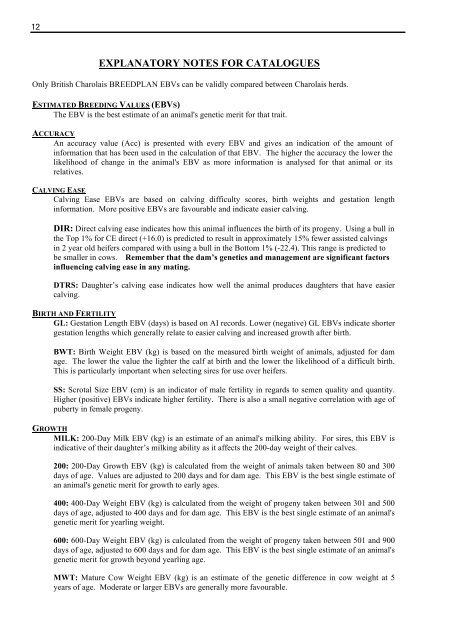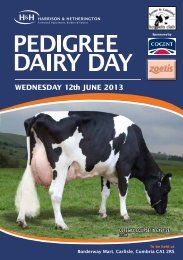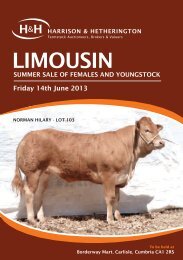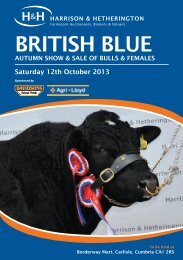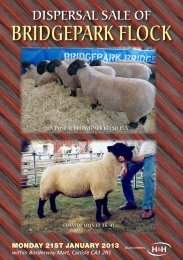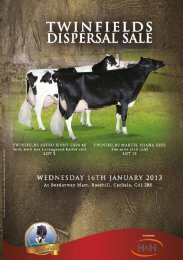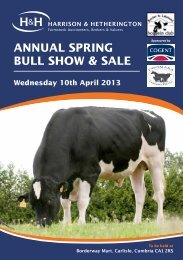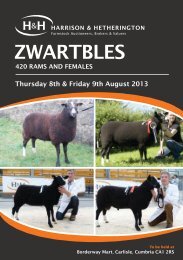CHAROLAIS - Harrison & Hetherington
CHAROLAIS - Harrison & Hetherington
CHAROLAIS - Harrison & Hetherington
Create successful ePaper yourself
Turn your PDF publications into a flip-book with our unique Google optimized e-Paper software.
12EXPLANATORY NOTES FOR CATALOGUESOnly British Charolais BREEDPLAN EBVs can be validly compared between Charolais herds.ESTIMATED BREEDING VALUES (EBVS)The EBV is the best estimate of an animal's genetic merit for that trait.ACCURACYAn accuracy value (Acc) is presented with every EBV and gives an indication of the amount ofinformation that has been used in the calculation of that EBV. The higher the accuracy the lower thelikelihood of change in the animal's EBV as more information is analysed for that animal or itsrelatives.CALVING EASECalving Ease EBVs are based on calving difficulty scores, birth weights and gestation lengthinformation. More positive EBVs are favourable and indicate easier calving.DIR: Direct calving ease indicates how this animal influences the birth of its progeny. Using a bull inthe Top 1% for CE direct (+16.0) is predicted to result in approximately 15% fewer assisted calvingsin 2 year old heifers compared with using a bull in the Bottom 1% (-22.4). This range is predicted tobe smaller in cows. Remember that the dam’s genetics and management are significant factorsinfluencing calving ease in any mating.DTRS: Daughter’s calving ease indicates how well the animal produces daughters that have easiercalving.BIRTH AND FERTILITYGL: Gestation Length EBV (days) is based on AI records. Lower (negative) GL EBVs indicate shortergestation lengths which generally relate to easier calving and increased growth after birth.BWT: Birth Weight EBV (kg) is based on the measured birth weight of animals, adjusted for damage. The lower the value the lighter the calf at birth and the lower the likelihood of a difficult birth.This is particularly important when selecting sires for use over heifers.SS: Scrotal Size EBV (cm) is an indicator of male fertility in regards to semen quality and quantity.Higher (positive) EBVs indicate higher fertility. There is also a small negative correlation with age ofpuberty in female progeny.GROWTHMILK: 200-Day Milk EBV (kg) is an estimate of an animal's milking ability. For sires, this EBV isindicative of their daughter’s milking ability as it affects the 200-day weight of their calves.200: 200-Day Growth EBV (kg) is calculated from the weight of animals taken between 80 and 300days of age. Values are adjusted to 200 days and for dam age. This EBV is the best single estimate ofan animal's genetic merit for growth to early ages.400: 400-Day Weight EBV (kg) is calculated from the weight of progeny taken between 301 and 500days of age, adjusted to 400 days and for dam age. This EBV is the best single estimate of an animal'sgenetic merit for yearling weight.600: 600-Day Weight EBV (kg) is calculated from the weight of progeny taken between 501 and 900days of age, adjusted to 600 days and for dam age. This EBV is the best single estimate of an animal'sgenetic merit for growth beyond yearling age.MWT: Mature Cow Weight EBV (kg) is an estimate of the genetic difference in cow weight at 5years of age. Moderate or larger EBVs are generally more favourable.


